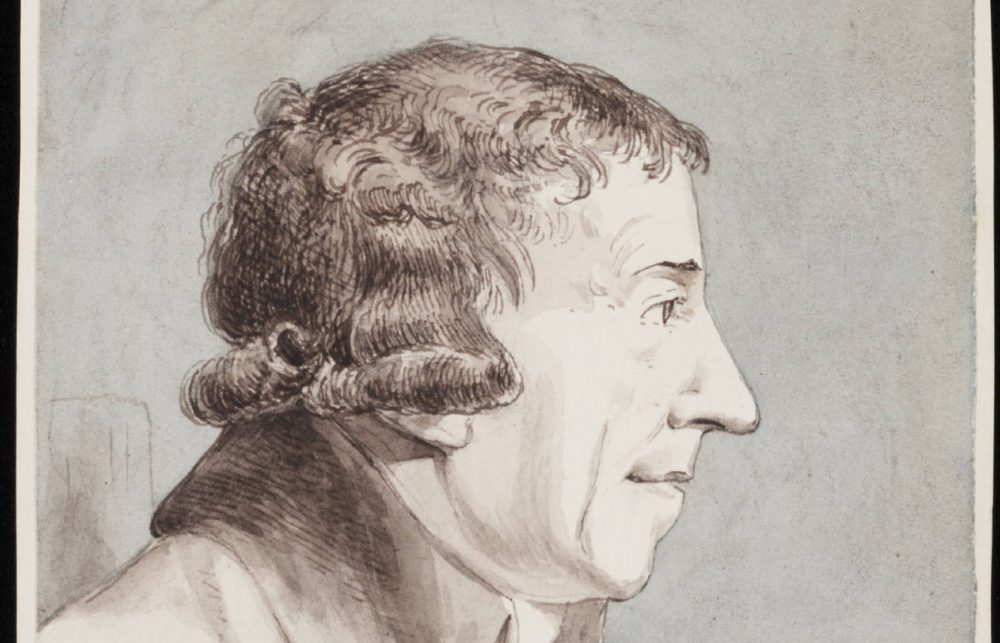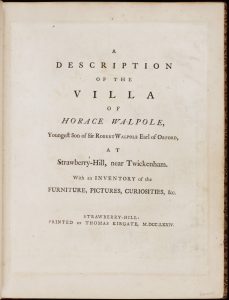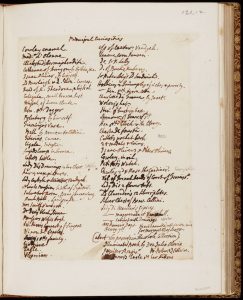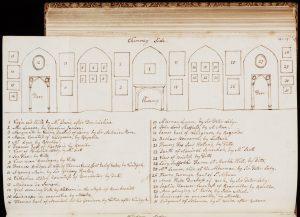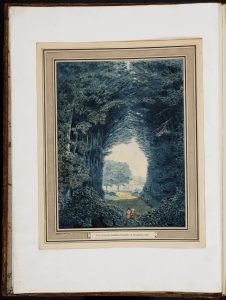15. Choices 8 and 9: Walpole’s Two Chief Copies of His Description of Strawberry Hill, Printed there in 1774 and 1784
By Wilmarth S. Lewis
“A Description of the Villa of Horace Walpole Youngest Son of Sir Robert Walpole Earl of Orford, at Strawberry Hill near Twickenham, with an inventory of the Furniture, Pictures, Curiosities, Etc. first appeared in 1774, a small quarto in an edition of 100 copies with six more on large paper, four of which are at Farmington, with ten of the smaller sizse. The second edition of 200 copies was printed in 1784, a large quarto with twenty-seven plates.
“The importance of the Description in Walpolian studies cannot be exaggerated. Choice 8 is Walpole’s copiously annotated copy of the first edition. His notes are on almost every page and there are fifty additional pages of drawings and text.
“Most of the notes report objects acquired after 1774; nearly all of them were used in the 1784 edition. An exception tells how in the Little Library in the Cottage ‘three of the antique sepulchral earthen lamps and some of the vases on the mantel were broken in 1777 when an own fell down the chimney.’ Besides the scores of marginal notes in Choice 8 Walpole added ten pages that he printed in the 1784 edition. They include ‘Explanation of the different coats of arms about the house at Strawberry Hill.’ ‘Collections [56 of them] from which were purchased many of the Curiosities at Strawberry Hill,’ a ‘List of the books printed at Strawberry Hill,’ and a list of ‘Works of Genius at Strawberry Hill by Persons of rank and Gentlemen not Artists,’ that will appear in Choice 11.
“There are also sixty-seven ‘Principal Curiosities’; among which were the silver bell designated by Benvenuto Cellini, ‘a bronze bust of Caligula with silver eyes at the beginning of his madness,’ ‘Callot’s Pocket Book’ which we met in choice 2, and a clock that the Description tells us was of ‘silver gilt, richly chased, engraved, and ornamented with fleurs des lys, little beads, etc. On the top sits a lion holding the arms of England, which are also on the sides. This was a present from Henry 8th to Anne Boleyn; and since, from Lady Elizabeth Germaine to Mr. Walpole. On the weights are the initial letters of Henry and Anne, within true lovers knots; at top, Dieu et mon Droit; at bottom The most happy.–One of the weights, agreeably to the indelicacy of that monarch’s gallantry, is in a shape very comfortable to the last motto.’ The clock, which is now at Windsor, has been a source of not altogether merriment since 1533. The drawing I value most in Choice 8 is Walpole’s own crude sketch, ‘Front of Strawberry hill to the garden as it was in 1747 before it was altered,’ the only view we have of it at that time.”
Lewis’s chapter, like the Descriptions themselves, covers the history of the house, its interiors and contents, and it provides details of graphic, printed, and manuscript additions to Walpole’s collection. Walpole, his friends, visitors, and subsequent writers are included. The chapter concludes with an account of the Strawberry Hill Sale of 1842.
“The Preface of the 1784 Description tells us that ‘. . . the following account of pictures and rarities is given with the view to their future dispersion . . . The several purchasers will find a history of their purchases; nor do the virtuosos dislike to refer to such a catalogue for authentic certificates of their curiosities. The following collection was made out of the spoils of many renowned cabinets; as Dr Mead’s, Lady Elizabeth Germaine’s, Lord Oxford’s, the Duchess of Portland’s, and of about forty more of celebrity. Such well attested descent is the genealogy of the objects vertu–not so noble as those of the peerage, but on a par with those of race-horses. It is all three, especially the pedigrees of peers and rarities, the line is often continued by many insignificant names,’ a classic description of ‘provenance,’ Walpole’s copies at Farmington of Lady Elizabeth Germain’s, Lord Oxford’s, and the Duchess of Portland’s sale catalogues, in which he noted his purchases and what he paid for them, illustrate the importance he gave ‘provenance.’ In the Duchess of Portland’s catalogue he pasted a four-page account of her that I printed for the Grolier Club in 1934.
“The fifty pages of drawings and manuscripts at the back of the ’74 copy I am saving begin with Sir Edward Walpole’s verses and drawings mentioned in Choice 3 and continue with sketches by Thomas Walpole, Horace’s favorite Wolterton cousin. There are caricatures of the Dukes of Cumberland and Newcastle by Walpole’s kinsman Lord Townshend, ‘the father of English caricature,’ and sketches by Lady Diana Beauclerk (whom we come to in Choice 11), by Mrs. Damer and other talented persons of quality. Finally, there is a printed title-page, the only one known, Catalogue of Pictures and Drawings in the Holbein-chamber at Strawberry Hill, wich is followed by plans that show where the pictures hung in the room.”
“Choice 9, Walpole’s extra-illustrated 1784 Description inlaid to elephant folio with his arms on the sides, was mentioned in Choice 4 because it contained the mezzotint of the Ladies Waldegrave. Choice 9 has two dozen water-color drawings of Strawberry by the ‘topographical’ artists who are at last coming into their own. Paul Sandby, Edward Edwards, J.C. Barrow, John Carter, William Pars, and J.H. Müntz.”
“There are twenty-seven copies of the ’84 Description at Farmington.* The second in importance to Choice 9 is Richard Bull’s copy, which I owe to H.M. Hake who was then Director of the National Portrait Gallery. It was his friendly practice on visits to country houses for purposes of probate to report whatever he knew would interest me. Bull’s copy of the Description with two other books from Strawberry Hill turned up in Nottinghamshire, and thanks to Hake’s intervention the new owners were happy to let me have them.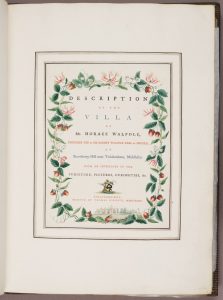
“Many of the drawings in Bull’s Description are finer than those in Choice 9, for Bull employed John Carter, one of the best topographical artists. Carter’s own set of the drawings is at the Huntington; a few of them are in Choice 9.”
*As of autumn 2017, the LWL now holds 31 copies of the 1784 edition of the Description.
Lewis, Wilmarth S. Rescuing Horace Walpole. New Haven and London: Yale University Press, 1978.
To see the full chapter from Rescuing Horace Walpole called Choices 8 and 9: Walpole’s Two Chief Copies of His Description of Strawberry Hill, Printed there in 1774 and 1784 download or expand the link here:
 Loading...
Loading...
N.B. Choice 8, Walpole’s heavily annotated 1774 edition bears the call number 49 2523 at the Lewis Walpole Library. It is sometimes referred to as the Spencer copy because it had been sold in 1919 for the Spencer Collection at the New York Public Library from which Lewis acquired it by exchange. It appears in A.T. Hazen’s Bibliography of the Strawberry Hill Press (1973 ed.) as no. 22, copy 3 and as catalogue number 2523 in A.T. Hazen’s Catalogue of Horace Walpole’s Library (New Haven: Yale University Press, 1969). Choice 9, Walpole’s copiously extra-illustrated 1784 edition of the Description has the call number Folio 49 3892 and appears in Hazen, A.T. Bibliography of the Strawberry Hill Press (1973 ed.) as no. 30, copy 12 and as catalogue number 3582 in A.T. Hazen’s Catalogue of Horace Walpole’s Library (New Haven: Yale University Press, 1969). The call number for the copy that belonged to Richard Bull is Folio 33 30 copy 11. It, too, appears in Hazen’s Bibliography and Catalogue.
